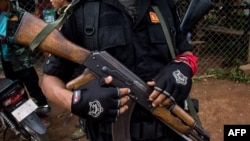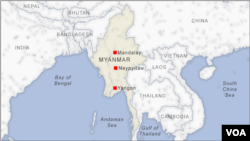Ethnic minority communities from Myanmar in the United States and elsewhere are pouring hundreds of thousands, possibly millions, of dollars into a growing guerrilla war against the country’s year-old military regime.
Rights groups say the junta has killed hundreds of civilians, arrested thousands and launched deadly attacks on whole villages in a bloody bid to take full control of the country since ousting a democratically elected government in February 2021.
For some of the ill-armed, cash-strapped militias fighting back, friends and family living abroad are proving a wellspring of funds to keep them going.
“Without their support it would be very difficult for us,” Timmy Htut, general secretary of the Chinland Joint Defense Committee, a planning body for armed rebel groups in western Myanmar’s Chin state, told VOA.
Last year’s coup set off weeks of mass protests. When soldiers and police began shooting into the crowds, communities across Myanmar, galvanized by the bloodshed, started taking up arms and forming militias to resist and fight the new regime. Some of them teamed up with established ethnic rebel armies that have been fighting the military for autonomy along the country’s borderlands for decades.
In Chin state, the eponymous homeland of Myanmar’s ethnic Chin, dozens of local militias have fused to form the Chinland Defense Force and allied with the Chin National Front, the area’s main ethnic rebel army. They set up the Chinland Joint Defense Committee to coordinate their operations against the military.
Timmy Htut said the Chin diaspora, spread across the globe by decades of persecution in majority ethnic Burman Myanmar, has been a critical lifeline for their cause.
“Most of the funds that we receive is from the people, our people who are already in the U.S. or [other] Western countries, and they are our ethnic people. They raise funds for us, and that’s most of the money that we receive,” he said.
Most of the foreign funding comes from the United States, he said, adding the Chin communities in Britain, Malaysia and South Korea to the list of top donors.
He would not tell VOA how much they were sending but said the CDF was spending it on the armed resistance “to equip our soldiers and also for the cost of the training.”
Foreign reserves
James Bawi Thang Bik, a community leader among the thousands of Chin who have resettled in Malaysia over many years as refugees, said Chin families there have sent the CDF more than $200,000 since April and were donating on a regular basis.
He said the money goes both to the armed resistance and to helping the thousands of civilians in Chin, as elsewhere, who have been driven from their homes by the fighting.
“We send the money to the CDF, and then of course they spend some for the weapons and they spend for food to support the refugees,” James Bawi Thang Bik said.
He said the militias “formed to defend our land and the life of our people. But this time they don’t get any international support … I mean like from another government.
“So, we decided that it is time for us to support each other and it is the time to recognize them as our own army. Because the Chin, we’ve wanted freedom and independence for many years, so this is going to be one of the best times and one of the best chances to go forward with what we want for our nation.”
A senior officer for of the U.S.-based CDF-Hakha Support Team of North America told VOA that his own group has sent the militia in the northern Chin state town of Hakha “hundreds of thousands” of dollars as well, with more to come.
“For example, if we are trying to support them, a gun in Chin state, like let’s say an M-16, AK-47, it costs about $6,000 [and] ... ammo costs about $10. So, we are trying our best to support them as much as [we] can,” he said, speaking on condition of anonymity for the safety of family members back in Myanmar.
Other Chin communities in the United States have set up their own groups to raise funds for militias affiliated with their particular tribes.
The cost of war
Min Zaw Oo, executive director of the Myanmar Institute for Peace and Security think tank, said militias in some other states where ethnic minorities dominate, including Kayin and Kayah in the east, have been tapping into their own communities abroad for funds.
Myanmar’s so-called National Unity Government, a shadow state forged from lawmakers ousted by the coup and other groups opposed to the junta, has been running international fundraisers for the broader resistance effort as well, he added, and sharing some of the money with the militias it has formed formal alliances with.
Taken together, Min Zaw Oo estimates that militias across Myanmar have raked in millions of dollars from abroad by now, supplementing the donations arriving from inside the country and what some of them earn by taxing local businesses.
That is still only a sliver of the billions of dollars at the disposal of the junta, which, at an estimated 350,000 troops, commands one of the largest armed forces in the region.
Even so, Min Zaw Oo said the foreign funds flowing to the resistance will ease one of the militias’ main handicaps, a dearth of weapons.
“The weapons prices [have] tripled compared to the pre-coup era, and the availability of weapons is also quite restricted because most of the weapons are so far coming from Thailand,” he said. “There are Thai smugglers, but they are not big smugglers … they are not [moving] like thousands of weapons. There are many small smugglers. They try to bring weapons [from] Thailand to sell the opposition in Myanmar.”
Some of the ethnic rebel armies are helping to arm the militias they team up with themselves. Min Zaw Oo said a few are also selling to the militias to cash in on the rocketing prices. He said an M-16 in near-mint condition that cost anywhere from $5,500 to $8,500 just over a year ago on the local black market now goes for upwards of $22,000.
“Because these weapons prices [are] spiking, the international funds are quite important for the groups to survive,” he said.
More money, he added, means “more weapons [and] explosives; a lot of them purchase explosives to set up IEDs,” or improvised explosive devices.
More than money
Some of those resettled abroad are committing more than just money. Timmy Htut, James Bawi Thang Bik and the CDF-Hakha Support Team said some have also gone back to Myanmar to join the fight with the militias. They would not share numbers.
James Bawi Thang Bik said some in Malaysia have approached his fundraising team seeking help with the trip but the team refused. He said he heard from their friends that they left anyway, using the same human smuggling networks that have helped refugees leave Myanmar to get them back in.
Timmy Htut said a Chin refugee who resettled in the United States after defecting from the Myanmar military several years ago was now back in Myanmar passing on his old training to the new militias.
The CDF-Hakha Support Team said some Chin have gone back from the United States as well.
With the junta still able to draw on a massive budget and military, and an armed resistance growing more organized and ambitious by the month, analysts see no imminent end to Myanmar’s post-coup crisis. The senior officer with the CDF-Hakha Support Team said foreign funds would keep flowing to the militias for as long as it lasts.
“This revolution must be the last one in Burma,” he said, calling Myanmar by its other name. “We believe that this dictatorship must end, so we all are responsible. If we are in unity to fight against the dictatorship, the military regime in Burma, then we will surely overcome, so this fundraising will be until the end of this revolution.”
The junta claims to be fighting a legitimate counterinsurgency campaign and has labeled the militias “terrorists.”
It says elections in 2020, which the military’s proxy party lost decisively, were riddled with fraud and that it ousted the government after its claims were ignored. The junta has provided no evidence to back up the claim. Local and international election observers say the poll largely reflected the people’s will.










